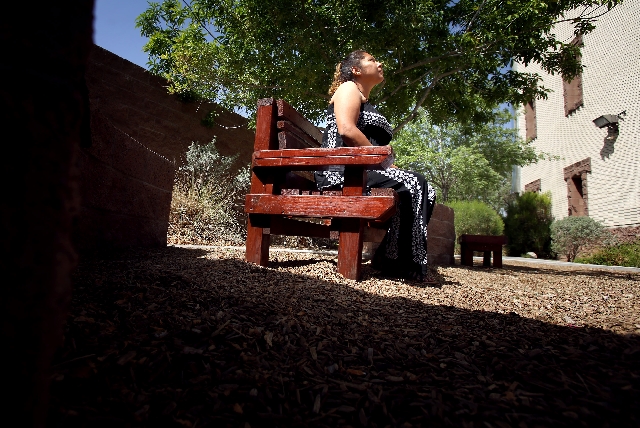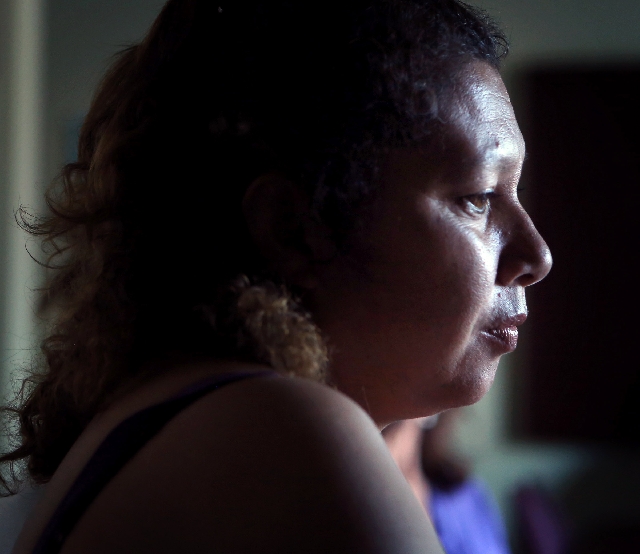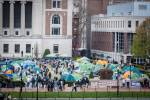Shade Tree shelter struggles with funding cuts


The only piece of clothing she had was the jacket on her back.
When Las Vegas police brought the 27-year-old victim of domestic violence to the Shade Tree shelter, a staff member rushed to her with two blankets.
It was Christmas time.
It was cold outside.
“It was traumatic,” she recalled last week.
The Detroit native, who asked not to be named, is one of about 350 women and children who call the Shade Tree home at night because they don’t have any other safe place to sleep, said Marlene Richter, the shelter’s executive director.
But as the number of people seeking services has gone up, funding to help accommodate them has decreased.
The Shade Tree was already hurting financially when its funding took another hit with the federal sequestration cuts that went into effect March 1. Other area homeless shelters haven’t been affected by the federal cuts but also have seen a spike in those needing services and a roof over their head.
Management at some shelters believe the Shade Tree’s financial situation could have ripple effects that could include an even greater increase of people seeking help at their shelters.
The Shade Tree in North Las Vegas has especially seen an increase of victims of domestic violence and sexual assault in the last 12 months, Richter said. It has been averaging 55 to 60 victims of domestic violence per month, said Richter, adding it’s not easy to explain the increase.
“It’s not one thing,” she said. “There are many stressors that are (having) an impact on our families.”
Something else that’s new to the Shade Tree — multigenerational groups are coming in, Richter said. Not too long ago, a grandmother, daughter and child arrived at the shelter.
At a time when the need is greater, services will be tighter.
The shelter has a clinic on site, where it provides medical care to clients. The clinic operates with funding from a five-year federal grant that is in its fourth year. The shelter received about $50,000 a year to operate the clinic, but that dropped by 15 percent March 1 when the sequestration cuts went into effect, Richter said.
That is the only federal cut the shelter has faced, thus far. But the 15 percent cut comes on top of several other losses the shelter has had to absorb.
Two years ago, the shelter received $40,476 from the city of Las Vegas from an emergency solutions grant. For the current fiscal year, which ends June 30, it received $25,000, Richter said.
For the next fiscal year, which starts July 1, it will receive only $11,470, she added.
For a separate city of Las Vegas grant, the shelter received $40,476 for the current year, but that is expected to drop to about $32,000 July 1, Richter said.
This year, the shelter was running short about $50,000 every month, she said. It’s annual operating budget is about $3 million.
“We are going through reserves,” she said. “The last thing that we needed was reductions in funding.”
But Richter said they are trying hard to not end the year in the red. They are trying to sell a 2.2-acre parcel of land that was donated to the shelter to help fund operations.
Last year, the shelter was able to close an $800,000 budget deficit with reserves that came from different restricted funds for various programs.
DEMAND FOR SHELTER SERVICES CLIMBS
Robert Brunner, executive director of the Las Vegas Rescue Mission, said his organization hasn’t been affected by the federal cuts because it’s privately funded and it doesn’t receive any federal grants.
“We are really not affected at all,” he said.
But his organization is seeing an increased demand for services.
“We are seeing an uptick coming to the rescue mission, maybe from other agencies that have to cut back,” he said.
His organization’s annual operating budget is $5 million, but he could use more.
The rescue mission serves about 30,000 meals a month, and the overnight shelters are always full, Brunner said.
The men’s shelter has 120 beds, the women’s has 40, and the family shelter has about 20 beds and can accommodate five to eight families, he said.
Leslee Rogers, spokeswoman for the Salvation Army of Southern Nevada, said they have seen the number of clients go up in the past four years.
“We are trying to do more work with less,” she said.
The Salvation Army offers shelter only during the winter, spring and summer. During the summer, its shelter with 120 free beds is usually 95 percent full. It also has about 120 paid beds, which cost $8.
The Salvation Army of Southern Nevada’s operating budget is about
$15 million a year, and it supports about 19 programs throughout Clark County.
Brunner said he is grateful to donors because about 80 percent of the rescue mission’s budget comes from private contributions.
And without places such as these, many people wouldn’t get a second chance to turn their lives around and get off the streets.
The 27-year-old woman who arrived nearly naked at Shade Tree has completed an eight-week domestic violence therapy class and is looking for work so that she can move into her own place.
“I feel better,” she said. “I feel closure. I feel independent and strong and confident.”
Ignelda Alejo, 43, has been at Shade Tree for eight months. She is hoping to reunite with her 3-year-old son soon. She is thankful for all of the services that the shelter has provided.
Alejo said without that helping hand, she probably would still be on the streets.
Now she is headed in a different direction.
“I want to be a better mom,” she said. “A better person.”
Contact reporter Yesenia Amaro at yamaro@reviewjournal.com or 702-383-0440.


















